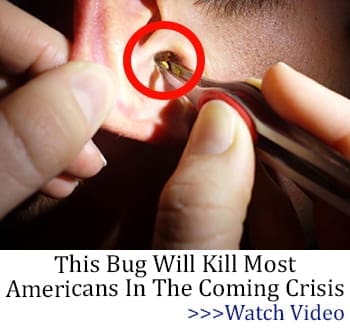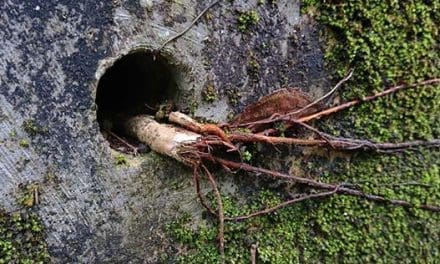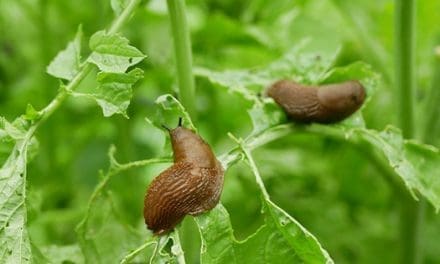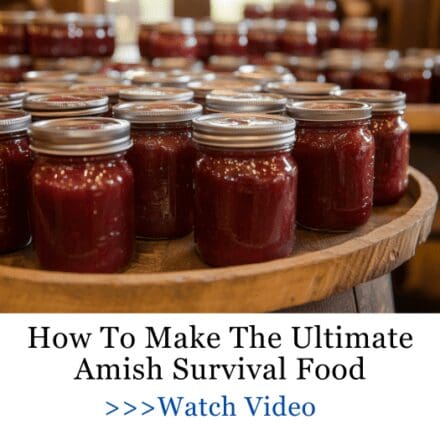Of all the ways you can make your homestead more self-reliant, few are as overlooked — or as surprisingly practical — as starting an insect farm. A food source so odd, most folks overlook it… yet it kept people fed through the harshest times. When pioneers crossed the plains and families scraped by during the Great Depression, they couldn’t afford to turn their noses up at any reliable food source, no matter how unusual. From roasted grasshoppers on the frontier to fried crickets in dust bowl kitchens, edible insects helped people survive when traditional food ran out.
A farm small enough to fit in a crate, quiet as a mouse, and tough enough to survive where gardens fail. Crickets, mealworms, and other edible insects have been a staple in traditional diets around the world for centuries — and now, homesteaders are rediscovering just how useful they can be. In fact, more than 2 billion people around the world still consume bugs as a regular part of their diet.
Curious how easy it is to build one of these miniature farms yourself? The answer might just surprise you.
Why Bugs?
It comes as a surprise to many, but in many parts of the world, insects are a regular part the daily diet.
This includes crickets, grasshoppers, worms, spiders, cicadas, grubs, dragonfly larvae, even ants and scorpions. They’re often sold as street food, and even appear on restaurant menus.
There are two reasons you might want to know about how to eat bugs. Either for the novelty of trying it just once, or as a prep for natural disasters, manmade disasters, or livestock pandemics. In that regard, insects become survival food and one of the best alternative protein sources you can find.
The simple fact is that insects are high in protein and, in some areas, protein sources are rare and hard to come by. It’s a vestige of an ancient diet where hunting and gathering often presented few options. But what’s interesting is that many animals commonly eaten like crabs, lobsters and crawfish have a similar lineage and body structure as many insects. They all have an exoskeleton, which is a hard casing surrounding the body in places bones. Surprising to some is the fact that lobsters and scorpions share a common, primitive ancestor.
So How Do You Eat a Bug?
The simple answer is that they’re cooked. Sometimes on a stick over an open fire, sometimes fried and sometimes boiled, or even added as a garnish to top a different dish. In many cultures, fried ants are used as a flavor enhancement to top food, because the formic acid in their abdomens has a piquancy similar to lemon or vinegar.
Are Insects Safe to Eat?
For the most part, yes. Venomous insects are a definite “no,” but non-venomous insects are often fit for the menu, although cooking is always recommended. The whole act of eating insects is actually referred to as “entomophagy.” And what comes as a surprise to many entomophagists is that many insects actually taste really good. In some countries, kids eat fried crickets and grasshoppers the way American kids eat pretzels and potato chips.
Insect Nutrition Facts
The most significant nutrient derived from insects is protein. Ounce for ounce, insects actually have more protein than beef and little – if any – saturated fats. They’re also high in omega-3 fatty acids and contain minerals like iron, zinc, magnesium and copper in amount far beyond an equal amount of beef.
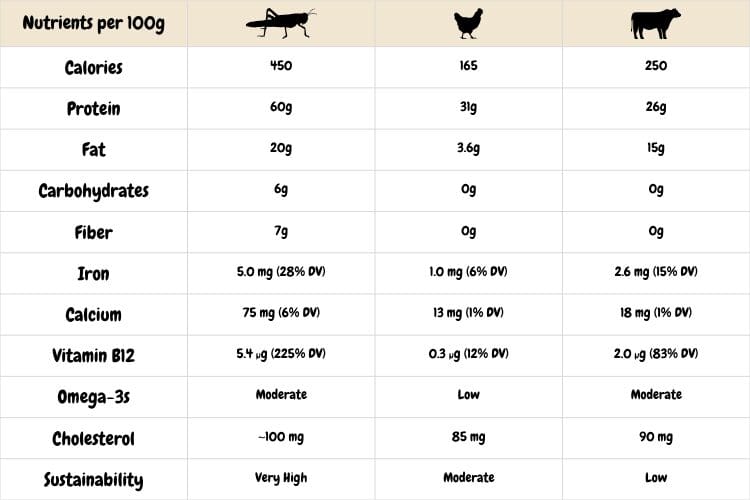
More Health Benefits Than You Thought
🧠Brain and Cognitive Support
Ever hit that midday brain fog—especially when you’re running on limited resources?
It’s frustrating. You’re doing all the hard work, but your brain just isn’t keeping up. Part of the problem? Lack of key nutrients like B12 and omega-3s, which are crucial for focus and mental stamina.
Here’s the good news: insects aren’t just weird survival food—they’re actually powerhouses for your brain, packed with B12, iron, and brain-boosting nutrients. Lightweight, easy to store, and ready to fuel your mind when traditional food options run low. B12 helps keep your memory sharp and supports clear thinking, which is something many folks struggle with as they get older.
But that’s not all — insects also pack healthy fats, including omega-3 and omega-6 fatty acids. These fats are essential for maintaining brain cell membranes and helping neurons communicate smoothly. Without enough of these fats, your brain might feel foggy or slow to react.
Also, insects provide choline, a nutrient that’s crucial for producing acetylcholine, a chemical messenger involved in learning and memory. Eating insects regularly could be a natural way to keep your mind agile and focused, especially when you’re juggling a busy homestead or daily tasks.
So, next time you’re thinking about brain fuel, don’t overlook those tiny critters! They’ve got more going for your cognition than you might guess!
But even with these vital nutrients from insects, your brain needs more than just fuel—it also needs repair and protection. That’s where Lion’s Mane Mushroom Tincture shines. Clinical studies show Lion’s Mane stimulates production of nerve growth factor (NGF), a key player in repairing and protecting the neurons involved in memory and learning. In a 16-week human trial, it improved cognitive function in people with mild memory loss—with none of the side effects common to pharmaceuticals.
Together, insects provide the essential building blocks your brain needs, while Lion’s Mane helps rebuild and protect those neural pathways. Pair cricket powder with Lion’s Mane tincture, and you’ve got a sustainable, all-natural brainfood superstack designed to keep your focus razor-sharp and your mind resilient—no matter where life takes you.
If staying mentally sharp and nourished is a priority for you, this combo is definitely worth a try.
💊Immune System Boost
Feeling like you catch every bug that comes around? (pun intended) Weak immunity can leave you stuck in bed and off your homestead game.
Loaded with zinc and iron, insects help your immune cells gear up and fight off infections naturally. Even better, they contain antimicrobial peptides, tiny natural warriors that tackle harmful bacteria and viruses before they take hold.
Edible insects like crickets are packed with nutrients that help your immune system stay strong. Their high-quality protein supplies the building blocks your body needs to make antibodies and repair tissues, essential when fighting off germs.
They’re also rich in minerals like zinc and iron, which are essential for immune cell function and boosting your body’s natural defenses. Zinc, in particular, plays a starring role in healing wounds and keeping your immune responses sharp.
Some insects also contain antimicrobial peptides—natural compounds that can help your body fend off harmful bacteria and viruses.
Including insects in your diet is a simple way to give your immune system steady support, without relying on complicated supplements or medicines.
But sometimes diet alone isn’t enough. That’s where the Eastern Blend Defense Tincture comes in. This powerful herbal mix works hand-in-hand with the nutrients in your diet, giving your immune system the extra muscle it needs to keep you healthy through every season.
So instead of relying on expensive supplements or endless sick days, try using this tincture—a simple, natural strategy to keep your defenses strong and your homestead humming.
🩺Digestive and Gut Health
Bloating, sluggish digestion, or feeling “off” after meals? You’re not alone. Poor gut health can drag down your energy, immunity, and even your mood, but there’s a surprisingly simple fix hiding in plain sight.
Crickets and mealworms are naturally rich in chitin, a special type of fiber that acts like fertilizer for the good bacteria in your gut. This helps balance your microbiome and keep things moving smoothly, without harsh cleanses or complicated routines.
Insects also contain enzymes and amino acids that support digestion and nutrient absorption, making your meals work for you instead of against you. Many folks don’t realize how much of their overall wellness starts right in the gut—and insects quietly do the heavy lifting.
If you’re looking for an extra nudge, pairing insects with a digestive tonic or fermented foods can really amplify the effect. But even on their own, these tiny critters offer a steady, natural way to support gut health—no synthetic pills required.
And for an even better result, I combine them with a few drops of the Balanced Gut Blend Tincture. It’s a simple mix of time-tested herbs that helps calm the gut and promote smoother digestion. The difference you feel? It’s almost immediate.
If your gut’s been sending up red flags lately, this might just be the fix you didn’t know you were missing.
🔥Anti-Inflammatory Effects
If your joints feel stiff in the morning… if you’ve got nagging aches that come and go… or if you just feel “off” more days than not—chronic inflammation might be at play. It builds up quietly, but over time, it can wear you down, both physically and mentally.
That’s where edible insects come in—yes, really.
Crickets and black soldier fly larvae, for instance, contain compounds like lauric acid and antioxidants that help naturally dial back inflammation. Some even have antimicrobial peptides that support the body’s natural healing response. So instead of reaching for another pill, you’re giving your body what it actually needs to settle things down from the inside out.
I started adding insects into my meals a couple of times a week—nothing fancy, just some cricket flour in my morning mix or roasted mealworms on top of a salad. But the difference? Noticeable.
When inflammation runs deeper—or you just want a more targeted solution—reach for Nicole Apelian’s Dual-Extracted Reishi Tincture. Reishi is known as the “mushroom of immortality” for a reason. It’s been used for centuries to help lower inflammation, support immunity, and bring balance back to the body. Nicole’s dual-extraction method pulls both the alcohol-soluble and water-soluble compounds from the mushroom, so you’re getting the full spectrum of benefits.
Getting Real About Eating Bugs
If you’re seriously considering bugs as an addition to your diet for any reason, you need think “inside the box.” Wild foraging for insects is always an option, but you may find they are both elusive and appear in small quantities. That’s why we’re going to explore the option of insect farming. Think of it as a small chicken coop for crickets. We’re also going to look at an option for earthworm farming. We’ll wrap up with some recipes for all, and even some serving suggestions.
The Benefits of Insect Farming
If you’ve tasted a few bugs and decide it’s something you think you would want to pursue as a nutritional option, here are some of the benefits worth considering: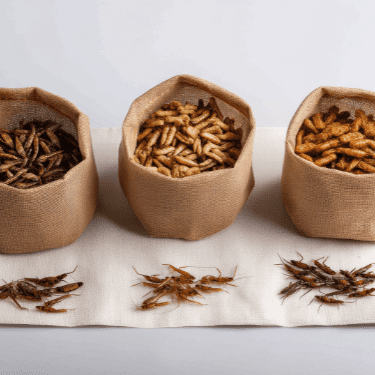
- An insect farm can provide you with a steady supply and is easily sustainable, taking up little space.
- An insect farm can also allow you to harvest a significant quantity well beyond any amount you could wild forage.
- Insect farming can be done at any time of the year as long as you keep them in an environment not exposed to freezing temperatures.
- An insect farm is portable and compact, so you can actually take it with you in the event of a bug-out, or if you only have limited space on your property.
- You can also feed insects to your livestock, especially poultry and pigs.
- Raising insects is cheap. The typical feed is all around you in nature.
- Insects breed prolifically. That’s why the word “infestation” often shows up next to word “insect.”
- Insect farming lets you raise the most nutritionally beneficial species. When wild foraging, you’re at the mercy of what you can catch. Farming your own let’s you raise the best.
- Most insects are highly resilient. That’s why it often takes harsh chemicals to eradicate them. That’s what happens after more than 600 million years of evolution.
- Compared to the cost and labor of livestock, insect farming is cheap. Just find your bugs for your brood stock and make them comfortable. They’ll reproduce rapidly.
- An insect farm is easy. They’re easy to find, easy to raise and compared to the anguish some people experience when slaughtering a pig or goat, insects are easier to kill. You can thank the mosquitoes for that emotion.
Pick Your Bugs
We’re going to focus on crickets and earthworms for now, although the farm concepts or structures could also work for many others, from meal worms to grasshoppers. Here is a chart covering the basics, and then we’ll get into the actual constructions of the small farms.
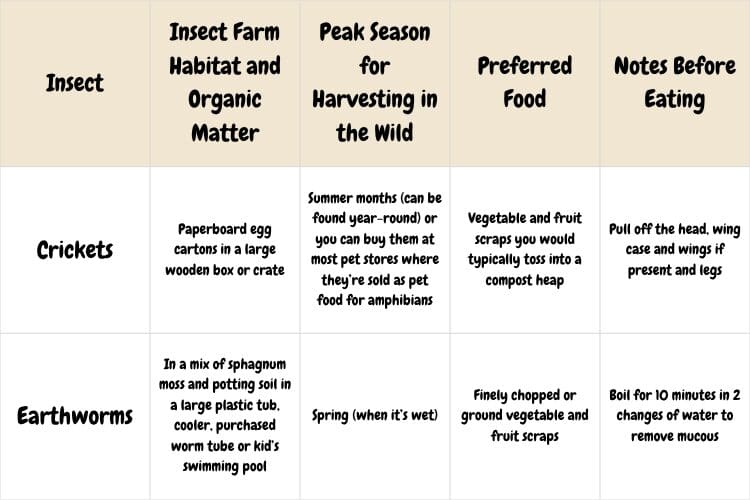
Constructing a Cricket Farm
The easiest way to construct a cricket farm starts with a large, plastic storage box with a lid.
The first step is to remove the lid and cut out a rectangle in the top and use duct tape to tape a section of screen over the top.
This will give the cricket farm plenty of air circulation.
The next step is to place stacked egg cartons vertically in one side of the box.

This gives the crickets a place to shelter, mate and rest. But you also need food, so a container with cricket food is placed inside, a carrot or some greens and a shallow dish with a water soaked sponge. You can buy crickets at many pet shops and once you’ve introduced your crickets to their new home, you cover the farm and check for when you need to add more food or water.
Constructing a Worm Farm
A worm farm requires a bit of construction. You’ll need some wood, screen for the top and bottom and various layers of felt, worm bedding and some drainage designs. Here’s a cutaway and then we’ll get into some details:
A worm farm is basically a box raised on legs. There are also two trays. A top tray and a bottom tray. The lid can either be screened or a piece of plywood with holes drilled on top for air circulation.
The top stray starts with a layer of liner material, usually a piece of felt topped with worm bedding that you can buy at a bait shop or fishing tackle store.
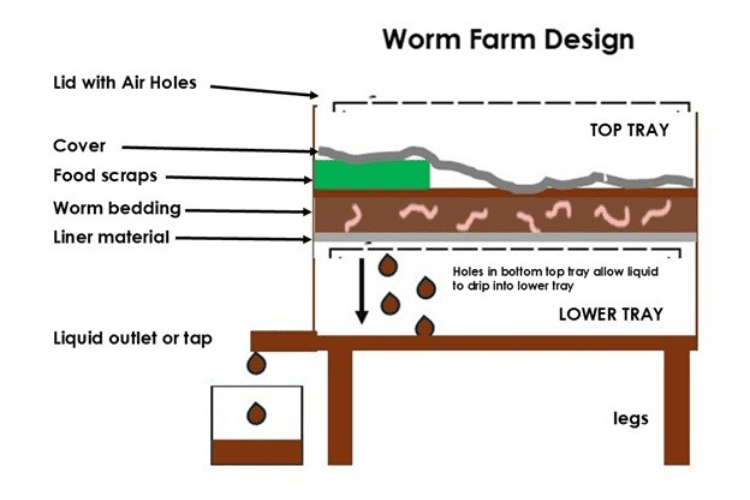
Food scraps are pile on one side of the box over the worm bedding and it’s all topped with another layer of felt. The felt helps to hold in moisture.
The bottom of the top tray is another layer of screen stretched tight or another piece of plywood with drainage holes drilled. A pipe or other outlet is placed into the bottom of the box so any excess moisture can drain.
You can collect your own earthworms (nightcrawlers are best) or buy your worms at the bait shop.
What is critical is to keep the farm well-watered and moist and to regularly feed your worms. They will reproduce and you can harvest as you go. Eventually, you may need to replace the worm bedding, but don’t throw it away. Put old worm bedding in the compost heap. It will give you super compost.
It’s Recipe Time!
Raising crickets and worms is one thing, but the real trick is knowing how to cook and eat them. Here are some recipe ideas.
CRICKET TACOS
Ingredients:
2 tablespoons of vegetable oil
1/2 yellow onion, minced.
2 cloves garlic, minced.
1-2 teaspoons minced Serrano pepper, seeds and ribs removed
1/2 teaspoon cumin
Kosher salt, to taste
2 limes
2 cups dry roasted crickets
8 corn tortillas
1 jar tomatillo salsa, store-bought or homemade
1 avocado, sliced
1/2 cup cilantro leaves, for garnish
Directions:
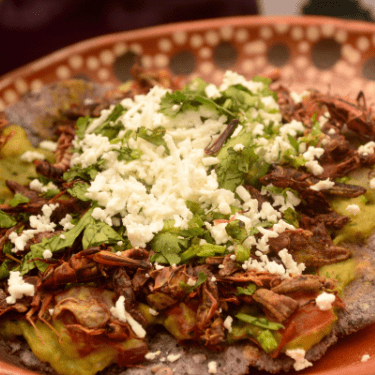
- Heat a large skillet over medium heat and add the oil. Add the onion and garlic and sauté until translucent, about 4 minutes.
- Add the Serrano, cumin, and season with salt and cook for another 2 minutes until fragrant. Add the zest and juice of one of the limes and cut the other lime into wedges and set aside.
- Add the crickets to the pan and toss to coat just until warmed through.
- To assemble the tacos, warm each tortilla over the flame of the stovetop burner, about 10 seconds per side and place on a plate. Alternately, wrap the tortillas in a damp kitchen towel and place on a sheet pan in a low oven to keep warm.
- Top each tortilla with the cricket mixture, some salsa, a slice of avocado, and cilantro leaves. Serve with a lime wedge.
Cooking with Earthworms
A cup of earthworms has 700 calories and contains 70% protein, 11% fat, and 21% carbohydrates. Potassium comes in at 1820 mg, phosphorus totals 1590 mg, calcium a surprising 444 mg, iron at 50 mg, zinc measured at17 mg, copper at 1.5 mg, iodine (a very important micro-nutrient) at 0.38 mg, and selenium measured at 0.40 mg.
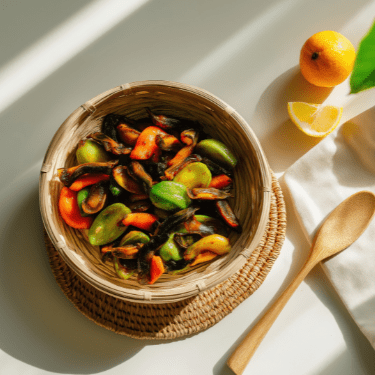 Surprisingly eating earthworms reduces cholesterol due to the presence of Omega 3 fatty acids. Earthworms have an earthy flavor (no surprise there), and they blend well with some dishes and spices particularly cumin, curry, paprika and chili powder.
Surprisingly eating earthworms reduces cholesterol due to the presence of Omega 3 fatty acids. Earthworms have an earthy flavor (no surprise there), and they blend well with some dishes and spices particularly cumin, curry, paprika and chili powder.
The most important thing to do before eating any earthworm is to give them a day to purge their gut. To do this, let them rest in moist sphagnum moss without any food. They will leave their tailings in the moss and after a day you can harvest them. Another option is to soak them in room temperature water for 4 hours. Surprisingly, they won’t die, and they will purge their tailings quickly.
You can refrigerate them in a plastic container with some sphagnum moss for 2 to 3 days or freeze them for 2 months.
One other step before eating earthworms is to remove the mucous layer that surrounds them. You can do this by boiling them for 10 minutes followed by a rinse in running water in a strainer. Once rinsed of all mucous you’re ready to try some recipes.
EARTHWORM SAUTE
Ingredients:
1 cup earthworms
1/2 large onion, chopped
1/2 cup water
1 bouillon cube
1 cup yogurt or sour cream
3 tablespoons butter
1/2 cup mushrooms
Flour for coating
Directions:
- Roll the worms in flour, brown in butter, add salt to taste.
(Note: Never deep fry earthworms. They are 90% water and will burst and disintegrate. Sauté them in a small amount of butter only.)
- Add ½ cup of bouillon and simmer for 30 minutes.
- Sauté onions and mushrooms in butter.
- Add onions and mushrooms to the worms.
- Stir in sour cream or yogurt.
- Serve over rice or noodles.
Bugs to Avoid
If you extend your insect farming efforts, you might want to keep in mind that some insects are poisonous, and some are just not worth the trouble. Here’s a quick chart for the insects to avoid:
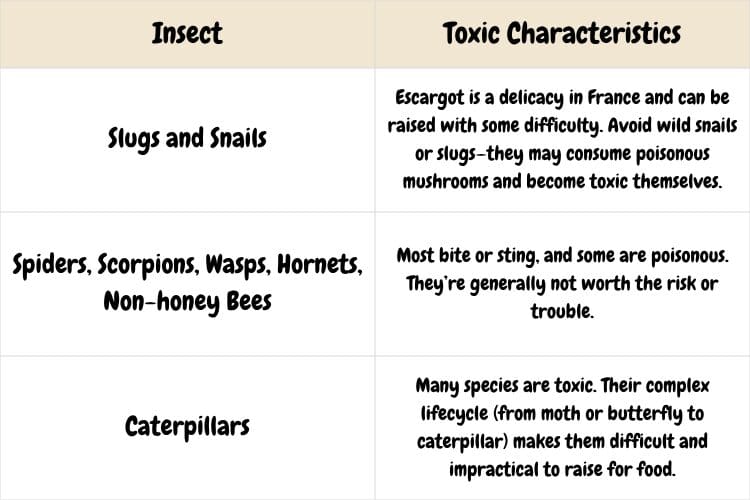
Preserving Bugs for the Long Haul
If you’re going to raise crickets or worms, it only makes sense to learn how to store them for the long term. After all, what good is a protein source if it spoils before you can use it? Luckily, preserving insects is easier than you might think — and it’s a skill worth knowing if you’re prepping for lean times.
Crickets are especially simple. Once they’re harvested and purged (a 24-hour fast on carrots works well), they can be roasted until completely dry and then stored in airtight containers. A low oven or a solar dehydrator works perfectly. You’ll know they’re ready when they become crisp and brittle. From there, you can grind them into cricket flour — a high-protein powder with a long shelf life, perfect for adding to bread dough, soups, or survival bars.
Worms are a bit trickier, but no less valuable. After purging and boiling, they can also be dehydrated until hard and brittle. Once dry, you can store them whole or grind them into meal. Some folks even smoke them lightly before drying, which adds flavor and helps with preservation. Earthworm meal can be used in soups and stews for an added protein boost — or mixed into feed for poultry during the winter months.
If kept cool and dry, both cricket flour and worm meal can last for months or even years, making them a smart addition to any prepper pantry or off-grid kitchen.
If you want to learn how to preserve food for decades for the pennies on the dollar, all you need to do is learn from the only people who have been living without electricity, toxin-ridden foods and modern conveniences for all their life. Here, you’ll get access to several never-before-seen videos where you can see:
- The deadly canning mistake the Amish never make (but most Americans do… without even realizing it)
- Why the Amish put this single leaf in their flour
- How they make powdered eggs
- How they store eggs for over a year—without a fridge, vacuum sealer, or added chemicals
And that’s barely scratching the surface of what these videos will reveal. They’re made by a former Amish who has been excommunicated for sharing these secrets with the outside world. So try and check them out before the videos get taken down!
Try Them First
If you have any thoughts about insect farming, you might want to try them first. You can buy cooked insects online or look for a restaurant that may actually offer them as a novelty item on the menu. You could also catch a few in the wild and try cooking them and see if you like them. Even if you don’t, you could always farm insects as food for livestock especially poultry.
Insect farming is easy to do, inexpensive and low maintenance. It also may be the only source of protein during desperate times so it’s at least worth knowing how to do this if you have to.
Dangerous Insects That Are Actually Good For Your Garden
How to Make the Ultimate Survival Food with a 25-Year Shelf Life (Video)
50 Powdered Foods That Last Forever
If You See This Jumping Worm In Your Garden, Kill It Immediately!




